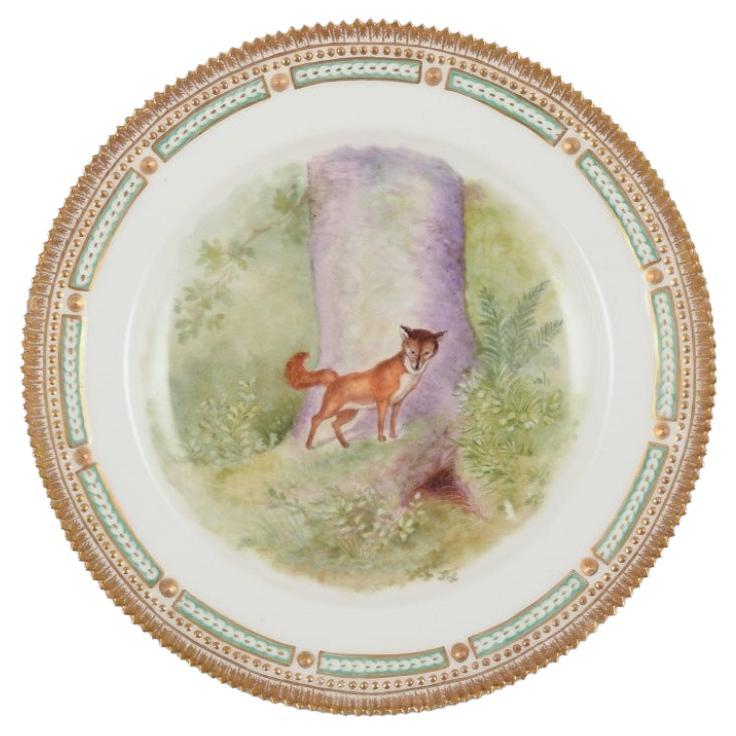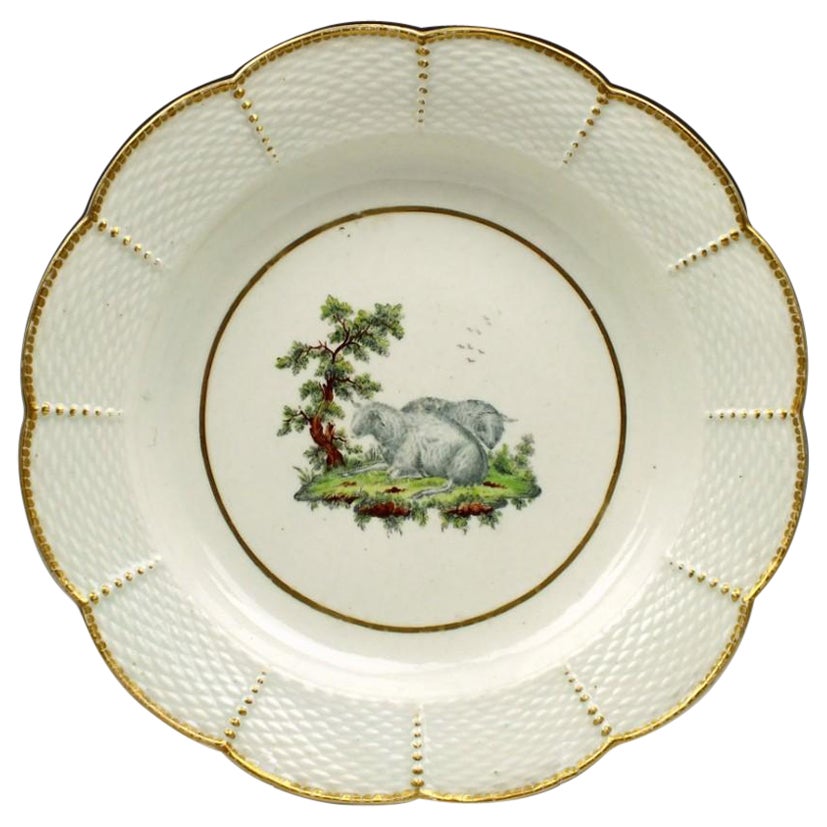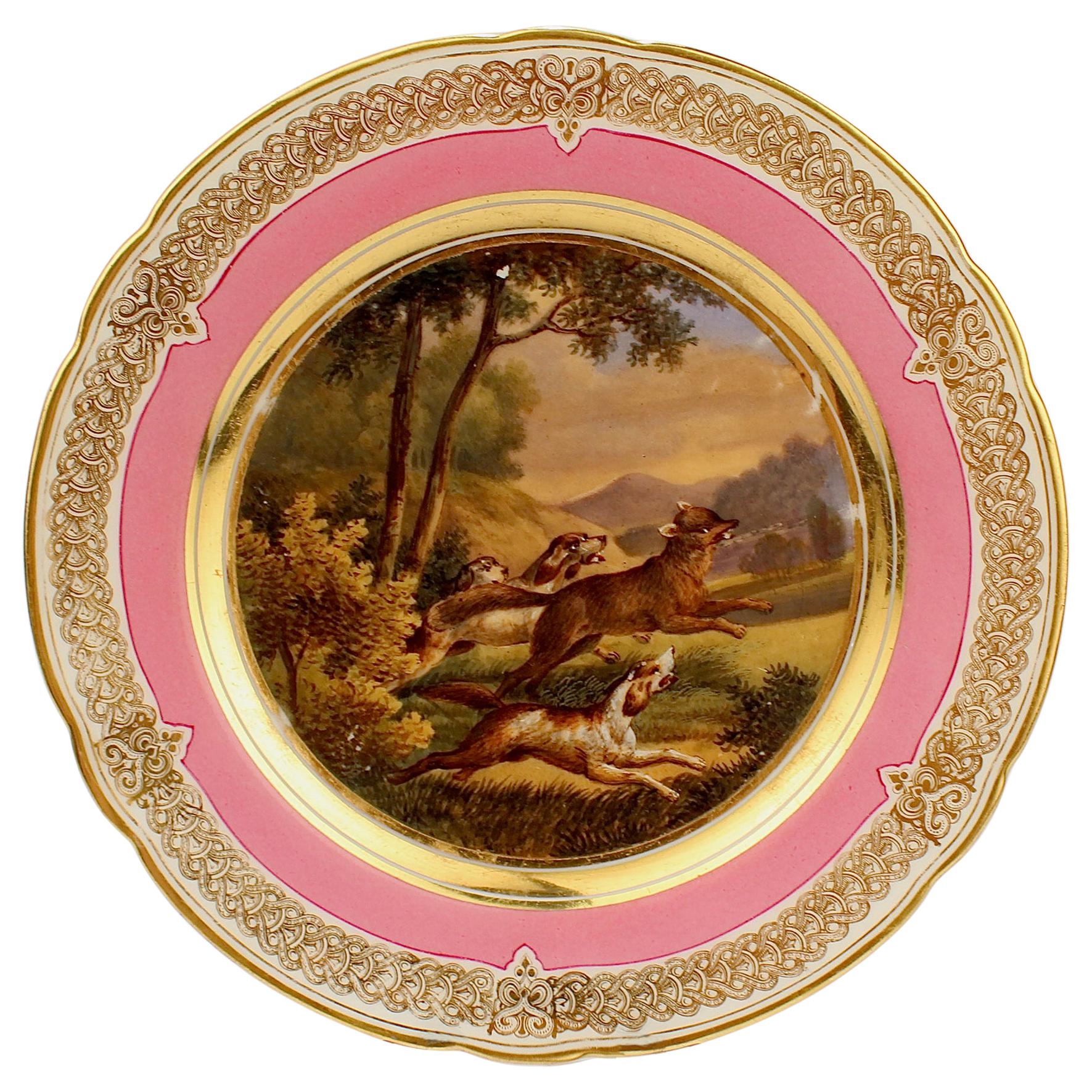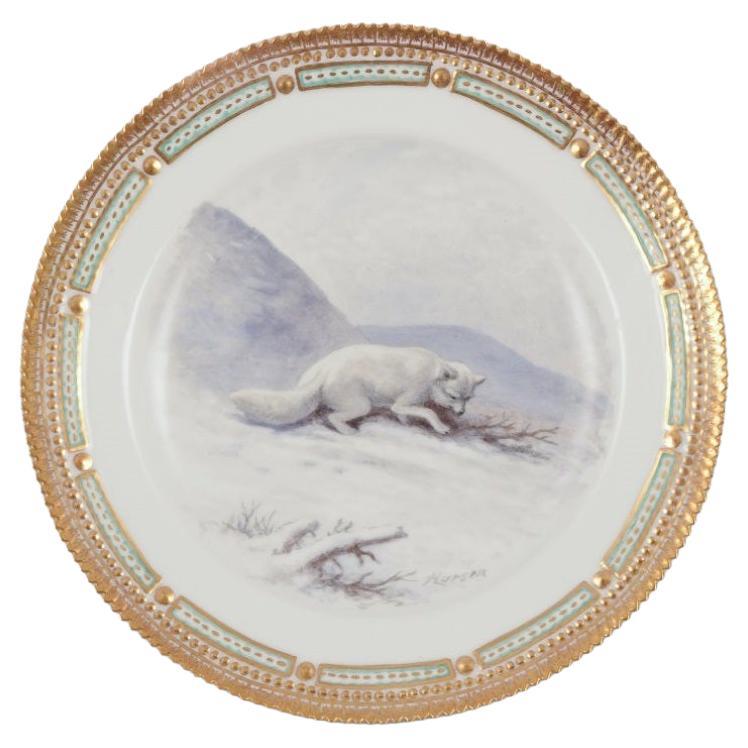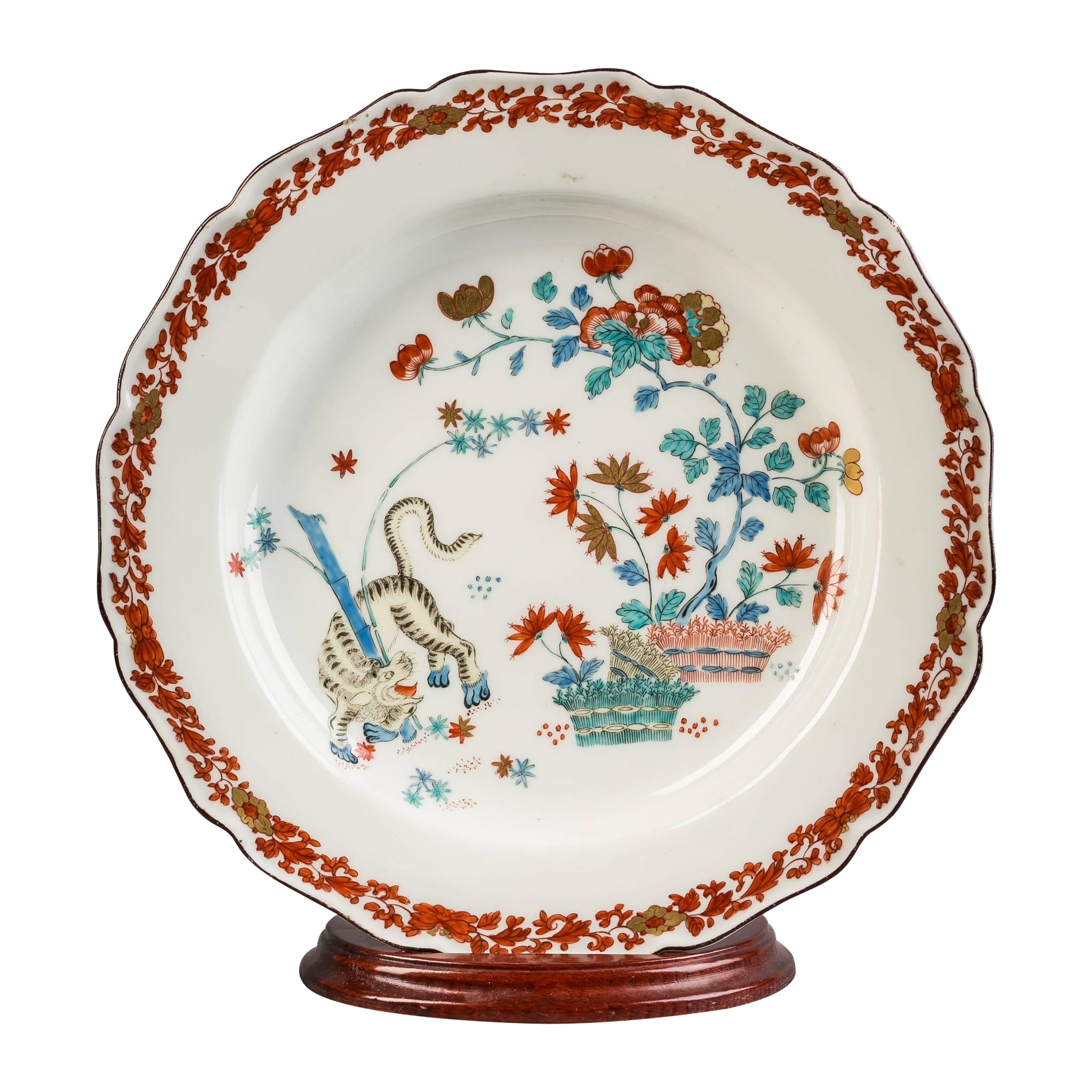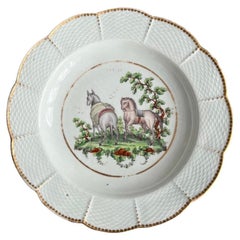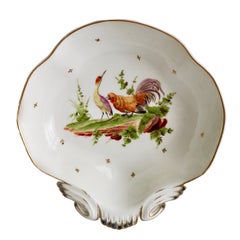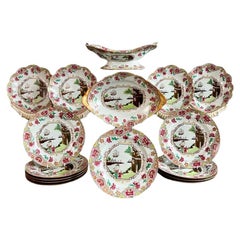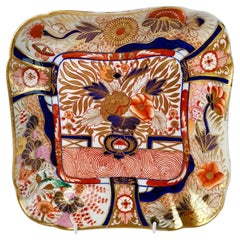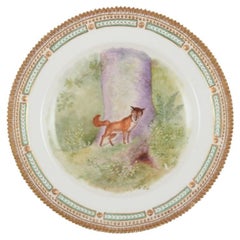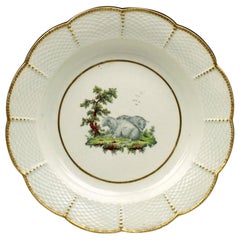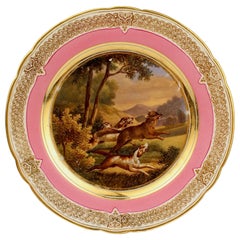Items Similar to Worcester Porcelain Deep Plate, Aesop Fable Three Foxes, ca 1780
Want more images or videos?
Request additional images or videos from the seller
1 of 14
Worcester Porcelain Deep Plate, Aesop Fable Three Foxes, ca 1780
$2,100
£1,591.15
€1,825.72
CA$2,955.04
A$3,248.40
CHF 1,707.21
MX$39,447.42
NOK 21,297.02
SEK 20,177.43
DKK 13,625.78
About the Item
This is a very rare deep plate made by Worcester around 1780. The plate has a basket weave rim and a very charming image of an Aesop fable about three foxes conversing under a large tree, one of them clearly having a flee problem. The image is painted in the style of Jefferyes Hamett O'Neale, who specialised in Aesop fable paintings. I have not been able to find the exact fable behind this image, but it is known that this plate belonged to a large service with many different Aesop fables.
I have one more plate of this service, with a fable of the horse and the donkey - please see separate listing.
It might be thought that this image was painted by Jefferyes Hamett O'Neale himself, but when looking closer you can see that the quality is not quite the same. However, it is clearly painted in his tradition and possibly by a student.
The Worcester Porcelain Company was one of the first potteries in Britain to produce porcelain. Alongside other great potteries such as Derby, Chelsea and Bow, they pioneered a new industry that would grow out to be huge in the following century. This plate is from the first period, which is often called the "Dr Wall" period after its founder. In later years Worcester went through many different ownerships and styles, and ultimately it became the Royal Worcester factory that only finished operation in the early 21st Century.
This beautiful plate has been potted in Worcester's famous early porcelain, which is rather warm to the touch as it contained a quantity of soap rock, and has a slightly green hue at the bottom. The underside also has characteristic concentric circles on the surface. The rim has a beautiful blind moulded "basket weave" pattern.
The plate is unmarked as was common at the time, but the style and porcelain body clearly indicate that it came from the Worcester factory.
Documentation: Several items of this service are shown in "Worcester Porcelain 1751 - 1790 The Zorensky Collection" by Simon Spero and Henry Sandon.
Provenance: Sir Jeremy Lever Collection, sold by Bonhams (Lot 89, 7 July 2007)
CONDITION REPORT The plate is excellent antique condition without damage, repairs or crazing, but it has minor wear as visible in the pictures.
Antique British porcelain is never perfect. Kilns were fired on coal, and this meant that china from that period can have some firing specks from flying particles. British makers were also known for their experimentation, and sometimes this resulted in technically imperfect results. Due to the shrinkage in the kiln, items can have small firing lines or develop crazing over time, which should not be seen as damage but as an imperfection of the maker's recipes, probably unknown at the time of making. Items have often been used for many years and can have normal signs of wear, and gilt can have signs of slight disintegration even if never handled. I will reflect any damage, repairs, obvious stress marks, crazing or heavy wear in the item description but some minor scratches, nicks, stains and gilt disintegration can be normal for vintage items and need to be taken into account.
There is widespread confusion on the internet about the difference between chips and nicks, or hairlines and cracks. I will reflect any damage as truthfully as I can, i.e. a nick is a tiny bit of damage smaller than 1mm and a chip is something you can easily see with the eye; a glazing line is a break in the glazing only; hairline is extremely tight and/or superficial and not picked up by the finger; and a crack is obvious both to the eye and the finger. Etcetera - I try to be as accurate as I can and please feel free to ask questions or request more detailed pictures!
DIMENSIONS 20.5cm (8") diameter
- Creator:1st Period Worcester Dr. Wall (Maker)
- Dimensions:Height: 1 in (2.54 cm)Diameter: 8 in (20.32 cm)
- Style:George III (Of the Period)
- Materials and Techniques:
- Place of Origin:
- Period:1780-1789
- Date of Manufacture:circa 1780
- Condition:Wear consistent with age and use. In perfect antique condition without damage, repairs or crazing, some minimal wear.
- Seller Location:London, GB
- Reference Number:Seller: A-WOR66a1stDibs: LU4805138702942
About the Seller
5.0
Vetted Professional Seller
Every seller passes strict standards for authenticity and reliability
Established in 2016
1stDibs seller since 2019
227 sales on 1stDibs
Typical response time: 1 hour
- ShippingRetrieving quote...Shipping from: London, United Kingdom
- Return Policy
Authenticity Guarantee
In the unlikely event there’s an issue with an item’s authenticity, contact us within 1 year for a full refund. DetailsMoney-Back Guarantee
If your item is not as described, is damaged in transit, or does not arrive, contact us within 7 days for a full refund. Details24-Hour Cancellation
You have a 24-hour grace period in which to reconsider your purchase, with no questions asked.Vetted Professional Sellers
Our world-class sellers must adhere to strict standards for service and quality, maintaining the integrity of our listings.Price-Match Guarantee
If you find that a seller listed the same item for a lower price elsewhere, we’ll match it.Trusted Global Delivery
Our best-in-class carrier network provides specialized shipping options worldwide, including custom delivery.More From This Seller
View AllWorcester Porcelain Deep Plate, Aesop Fable Horse and Donkey, ca 1780
By 1st Period Worcester Dr. Wall
Located in London, GB
This is a very rare deep plate made by Worcester around 1780. The plate has a basket weave rim and a very charming image of the Aesop fable of the horse and the donkey in the centre....
Category
Antique 1780s English George III Porcelain
Materials
Porcelain
French Porcelain Serving Dish, Heron and Cockerel La Fontaine, circa 1820
Located in London, GB
This is a incredibly charming shell-shaped serving dish made by an unknown maker in France in circa 1820. The dish is modelled in the Sèvres style and decorated with hand painted sce...
Category
Antique 1820s French Regency Platters and Serveware
Materials
Porcelain
Spode Dessert Service, Ship Pattern no. 3133 on Stone China, 1813-1822
By Spode
Located in London, GB
This is a stunning and rare Spode dessert service made between 1813 and 1822, consisting of a centre piece, a lozenge shape dish, four shell dish...
Category
Antique 1810s English Regency Porcelain
Materials
Stoneware
Chamberlains Worcester Porcelain Dish, Nelson or Fine Old Japan pattern, ca 1805
By Chamberlains Worcester
Located in London, GB
This is a striking square serving dish made by Chamberlains in Worcester around 1805. The dish bears the Fine Old Japan pattern, often called the Nelson pattern.
Robert Chamberlai...
Category
Antique Early 1800s English Georgian Serving Bowls
Materials
Porcelain
Crown Derby Porcelain Plate, Puce Cherubs by Richard Askew, Georgian ca 1785
By Crown Derby
Located in London, GB
This is a beautiful Crown Derby plate made in about 1785. The very charming decoration of a puce putto is by Richard Askew.
The Derby Porcelain factory has its roots in the late 174...
Category
Antique 1780s English Georgian Dinner Plates
Materials
Porcelain
Yates Plate, White, Gilt Shark Teeth Pattern and Floral Reserves, ca 1825
By William Yates
Located in London, GB
This is beautiful plate made by the Yates factory in about 1825. The plate is decorated with in a white ground with finely hand painted flower reserves, gilt sprigs and a characteris...
Category
Antique 1820s English Regency Porcelain
Materials
Porcelain
You May Also Like
Royal Copenhagen Fauna Danica, dinner plate featuring a motif of a fox.
Located in København, Copenhagen
Royal Copenhagen Fauna Danica, dinner plate featuring a motif of a fox.
Hand-painted. Gold rim.
Painted outside the factory.
Dating: 1926
Signed by Dodo.
Perfect condition.
Second fa...
Category
Vintage 1920s Danish Dinner Plates
Materials
Porcelain
First Period Worcester Fable Dessert Plate Ex Lever Collection, c1775
By 1st Period Worcester Dr. Wall
Located in Tunbridge Wells, GB
First Period Worcester Fable Dessert Plate Ex Lever Collection, c1775
Additional information:
Date : c1760-80
Period : George III
Marks : Unmarked
Origin : England
Colour : Polychro...
Category
Antique 18th Century English George III Porcelain
Materials
Porcelain
Antique Pink Border Paris Hand Painted Porcelain Fox Hunt and Dog Scene Plate
By Darte Frères
Located in Philadelphia, PA
A wonderful antique 19th century Paris porcelain plate.
With a hand painted scene of a fox hunt in a bucolic landscape including a fleeing fox and 3 hounds in chase.
It has a ...
Category
Antique 19th Century French Beaux Arts Dinner Plates
Materials
Porcelain
Royal Copenhagen Fauna Danica, dinner plate featuring a motif of an arctic fox.
Located in København, Copenhagen
Royal Copenhagen Fauna Danica, dinner plate featuring a motif of an arctic fox. Gold rim.
Hand-painted by H. Larsen.
Painted outside the factory.
Dating: 1926
Marked.
Perfect conditi...
Category
Vintage 1920s Danish Dinner Plates
Materials
Porcelain
English Porcelain Plate, Worcester, circa 1760
Located in New York, NY
Decorated with a tiger encircling a bamboo.
Category
Antique 1760s Porcelain
Materials
Porcelain
Copeland Spode Pottery Fox Hunt Lunch Service
Located in Essex, MA
A fox hunting set with all items listed below in the additional comments section.
Category
Early 20th Century English Pottery
Materials
Pottery
$2,850 / set
More Ways To Browse
Aesops Fables
Meissen Onion Pattern Plate
Meissen With Lid
Porcelain Cameo
Rosenthal Lotus
Royal Copenhagen Sugar
Versace By Rosenthal
Vienna Augarten
Yellow Porcelain Plates
Antique Coalport Dishes
Antique Porcelain Vegetables
Bavaria Gold Porcelain
Bjorn Wiinblad Rosenthal Lotus
Blue Compote
Blue Limoges Plates
Dessert Plates German
Dragon Cup
Edward Love
